Effective Strategies for Preventing Yellow Toenails
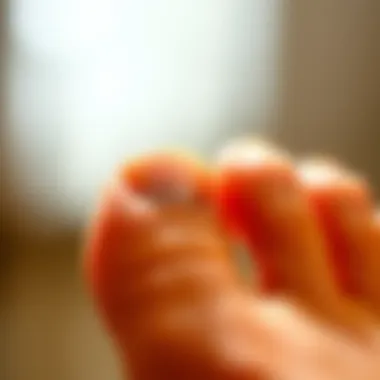
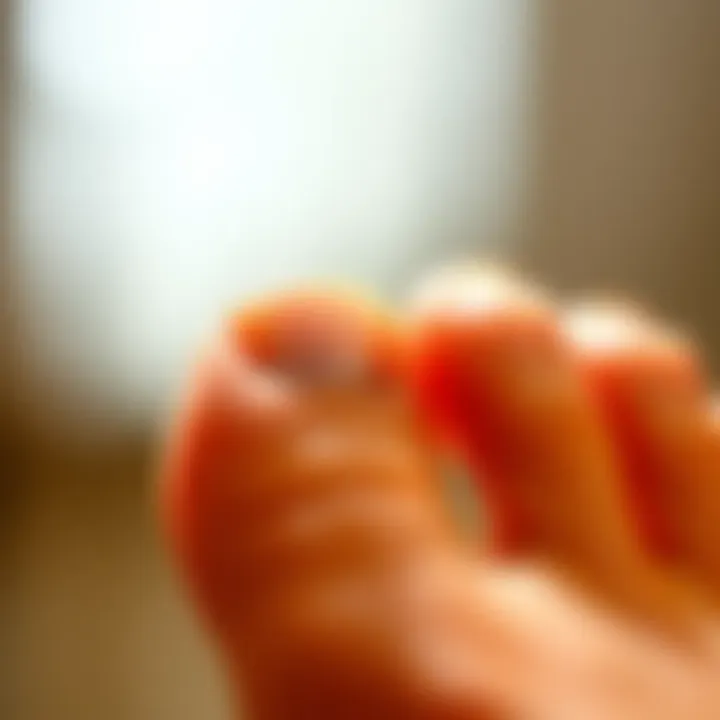
Intro
Maintaining toenail health is not merely an aesthetic endeavor; it’s a vital component of overall hygiene and personal well-being. Yellow toenails can be an unattractive nuisance, potentially signaling underlying health issues or improper care. Given that women of all ages are often conscious about grooming, it's important to take a closer look at the factors leading to nail discoloration. By understanding the causes and implementing effective prevention strategies, brighter and healthier toenails are within reach.
This article aims to illuminate various strategies that can be used to prevent yellow toenails, offering insights into hygiene practices, lifestyle choices, and remedial actions. It's never too late to turn around your nail-care game and ensure those tootsies stay fabulous.
Tips and How-Tos
One of the first steps toward maintaining healthy toenails is establishing a consistent skincare routine tailored to your needs. While the focus is often on hand care, toenails can often fall by the wayside.
Nail Hygiene Practices
- Keep Them Clean: Regular washing with soap and water is a must. Dirt, sweat, and debris can make your toenails look dull and unhealthy. Aim for a thorough clean every day if possible.
- Trim Regularly: Keeping your toenails trimmed can help prevent them from splitting and catching on socks or shoes, reducing the likelihood of injury and infection.
- Moisturize: Just like your skin, your toenails need moisture. Using a quality foot cream can help. Focus on the cuticles as well—dry cuticles can lead to nail discomfort.
- Use Anti-Fungal Products: If you’re often in wet conditions, consider using an over-the-counter anti-fungal powder as a preventive measure.
Choosing Nail Products with Care
Avoid using nail polishes with harmful chemicals like formaldehyde or toluene. Opting for brands that focus on natural ingredients can make a significant difference. While colorful nails are visually appealing, these chemical-laden products can contribute to discoloration. Instead, consider using products that are breathable or designed specifically to enhance nail health.
Lifestyle Choices
Excercise and diet play critical roles in maintaining nail health. A good diet rich in proteins, vitamins, and minerals can foster better nail strength and color. Incorporate plenty of foods that are high in biotin, such as eggs, nuts, and leafy greens, which have been noted for their benefits to nail quality. Staying hydrated is equally important as it keeps both skin and nails nourished.
"Strong nails often reflect a strong body; caring for your health supports your physical appearance."
Sustainable Practices
To ensure an eco-friendly approach to nail health, consider sustainable grooming habits and brands that prioritize environmental responsibility. Choosing products that eliminate toxic chemicals can have a dual benefit: supporting personal health while also being kinder to the planet.
Eco-Friendly Brands for Toenail Care
Search for brands that guarantee cruelty-free practices and use natural ingredients. Some popular companies, such as Zoya and Kure Bazaar, focus on sustainability without compromising on style. By making conscious choices in your nail care products, you not only protect your toenails but also contribute to broader ecological efforts.
Tips for Sustainable Grooming
- Invest in Reusable Tools: Instead of disposable nail clippers and files, choose quality, reusable tools that last longer.
- Local Alternatives: Support local brands or artisans that prioritize natural ingredients and environmental conservation.
- Reduce Waste: Minimize your consumption by choosing multifunctional products.
Celebrating Diversity in Beauty
Beauty comes in many shapes and colors. Understanding that nail health can be impacted by different cultural practices is essential for a comprehensive approach. Diverse perspectives on beauty can influence our choices and care routines.
Inclusive Brands
There are brands like Fenty Beauty or Juvia's Place that have made significant strides in promoting inclusivity. They emphasize that all skin tones and types can celebrate their beauty effectively, encouraging others to do the same in the realm of personal care.
Cultural Influences on Fashion
Nail art varies widely across cultures, from the simple elegance of Japanese nail paint to the intricate designs typical in Indian weddings. Embracing these influences can help broaden one's perspective on nail care, inspiring new and exciting approaches while ensuring that the foundation of nail health remains solid.
As you explore these strategies, remember that nail health is just as important as other aspects of beauty. By using thoughtful practices and sustainable products, you can keep your nails vibrant and healthy well into the future.
Understanding Toenail Discoloration
Understanding toenail discoloration is critical, as it paves the way for preventive measures and better overall nail health. Discoloration isn’t just a cosmetic issue; it could signal underlying health concerns or lifestyle problems. Therefore, grasping the reasons behind yellow toenails allows for timely interventions, ensuring beautiful and healthy feet.
The Anatomy of Toenails
To understand why toenails change color, it's essential to dive into their structure. Toenails are composed of a protein called keratin, which is the same material that makes hair and skin. Each toenail has three main parts: the nail plate, nail bed, and the cuticle. The nail plate is the visible part of the toenail, while the nail bed lies beneath it and supports growth. The cuticle protects the area between the skin and the nail. When any of these components face issues, discoloration can occur.
Identifying Common Nail Colors
Toenails can showcase a variety of hues, each signaling something unique. Healthy toenails are typically pink or beige, this coloration showcases good blood circulation and proper nail growth. However, nails with yellowing might indicate health issues such as fungal infections, or they could be affected by external factors, like nail products or fungi.
Causes of Yellow Discoloration
Fungal Infections
Fungal infections are a leading cause of yellow toenails. When fungi invade the nail bed, they thrive in moist environments. This leads to an overgrowth that may take root underneath the nail. The distinct characteristic of fungal infections is the thickening and discoloration of the nail. If left unaddressed, fungi can cause discomfort and may require medical treatment. In the context of this article, understanding fungal infections is vital as they are prevalent yet often overlooked. A unique aspect is that these infections can spread not just across nails but also from person to person, amplifying the importance of preventive strategies.
Health Conditions
Various health conditions can lead to yellowing of toenails. Diabetes, psoriasis, and respiratory diseases are significant culprits. These conditions can disrupt nail health, leading to changes in color as the body struggles to maintain normal functionality. The telling aspect of health-related yellowing is that it often appears alongside other symptoms, such as pain or discomfort in the nails. Highlighting these health implications in this article is beneficial, as it encourages readers to seek advice from health professionals at the first sign of discoloration.
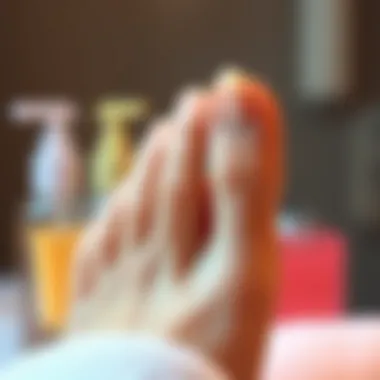
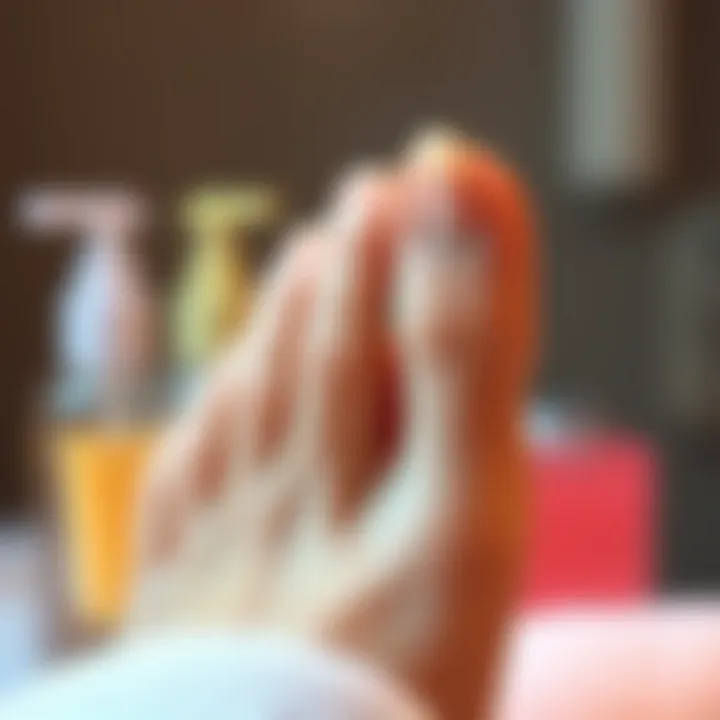
Nail Polish and Chemicals
Another contributor to yellow toenails is the use of certain nail polishes and other chemicals. Many nail products contain harsh chemicals that can stain the nails over time, especially those with darker pigments. The commonality of this problem is significant; many individuals may not realize the long-term impact of frequent polish use. A key feature of this concern is that choosing better, less damaging nail products can mitigate discoloration risks while promoting overall nail vitality.
Poor Foot Hygiene
Neglecting foot hygiene can also lead to ugly yellow nails. When feet are not cleaned thoroughly, dirt and bacteria can accumulate, causing discoloration. Regular washing and grooming are quintessential for avoiding this issue. The notable aspect of poor foot hygiene is that it can often be easily rectified with consistent care, making it a primary focus when discussing strategies for maintaining healthy toenails.
Good foot hygiene is not just about aesthetics; it's a gateway to preventing nail discoloration.
Through these examinations, the article will unfold the various aspects leading to yellow toenails and provide insights into how to combat these issues effectively.
Evaluating Lifestyle Choices
Maintaining the health of toenails is a multifaceted task, and much of it hinges on the lifestyle choices we make daily. Evaluating these choices is crucial in preventing yellow toenails and ensuring vibrant feet. Lifestyle elements can either bolster or harm nail health, and understanding their impact provides insights into necessary adjustments. This section explores two pivotal areas: footwear selection and hygiene practices, delving into how each segment influences toenail aesthetics and overall health.
Footwear Selection
Choosing Breathable Materials
Choosing breathable materials for footwear has a direct impact on toenail health. Breathable shoes are designed to allow air circulation, keeping feet cooler and reducing moisture build-up. Moist environments can be a breeding ground for fungi and bacteria, leading to discoloration and other issues. Materials like canvas or leather, known for their ventilation properties, can be smart selections.
One characteristic that stands out about breathable materials is comfort. They tend to mold to the shape of the foot better, reducing friction and the risk of blisters. With each step, more air circulation helps maintain a balanced moisture level, enhancing nail and skin condition alike. On the other hand, the downside can be susceptibility to wear and tear, especially with cheaper options.
Impact of Tight-Fitting Shoes
The impact of tight-fitting shoes on toenail health should not be underestimated. Found commonly in fashionable brands, tight shoes can constrict the foot's natural shape, leading to a host of problems including ingrown toenails and yellow discoloration. When toenails are squeezed, they might weaken over time, causing them to turn yellow as a sign of stress.
A key characteristic of tight-fitting shoes is that they can lead to reduced blood circulation. This situation isn’t just uncomfortable; it can hamper the delivery of essential nutrients and oxygen to the toenails, potentially worsening their condition. Choosing looser, properly fitting options can lessen these risks significantly.
Hygiene Practices
Daily Cleaning Routines
Establishing daily cleaning routines can dramatically improve nail health. This practice involves regularly washing the feet with mild soap and warm water. It’s more than just a mindful habit; cleaning feet daily helps to eliminate dirt and bacteria that can contribute to yellow toenails. A key aspect is attention to detail, making sure to scrub between the toes and around the nails, which are often overlooked areas.
This simple yet effective step can lead to long-term benefits for nail health. While some might consider it a chore, it indeed pays off in preventing discoloration and infection. However, one must be cautious not to overdo it, as excessive washing may strip the skin and nails of natural oils.
Drying Techniques
Drying techniques are essential after cleaning. Wetness around the toenails can lead to fungal growth, a primary contributor to yellowing. Patting the feet dry with a clean towel is generally recommended. Yet, many may overlook not just the act of drying but the method; using a cotton towel might be gentler and can absorb moisture well.
Another effective method is air drying, allowing feet to breathe and completely evaporate any remaining moisture. Choosing the right technique can vary among individuals; some might find towel drying to be more practical. Still, everyone should prioritize ensuring toes are squeaky clean and completely dry to thwart potential fungal developments.
"A stitch in time saves nine." Keeping up with foot care and hygiene can prevent larger issues down the road.
By reviewing and honing daily habits related to footwear and hygiene, it becomes possible to maintain a brighter, healthier appearance for toenails. Integrating breathable footwear and implementing a solid hygiene routine can significantly diminish the potential for yellow nails.
Preventive Measures for Healthy Toenails
Preventing yellow toenails necessitates a mindful approach to nail health. Poor practices, be they aesthetic choices or lifestyle habits, often lead to unwanted discoloration. Focusing on preventive measures not only maintains the visual appeal of toenails but also signals overall foot hygiene. A proactive stance taken today pays dividends in the long run, making it essential for every nail care enthusiast to navigate this territory with a discerning eye.
Maintaining Adequate Moisture
Moisture levels in toenails are crucial for their health. When nails lack hydration, they become brittle and more susceptible to discoloration and breakage. Many a time we underestimate the importance of moisture, particularly in dry climates or seasons. Striking a balance is key —keeping toenails neither too dry nor overly moist helps prevent structural damage.
Here’s how to ensure your toenails retain the right amount of moisture:
- Use a Good Foot Cream: Look for creams that have urea or lactic acid; they deeply penetrate and hydrate.
- Soak Your Feet: Once a week, a warm soak with some Epsom salts can rejuvenate your nails while promoting circulation.
- Protect Your Nails: Use gloves if working with water or harsh cleaners. Just think of it like putting on rain boots when there’s a downpour.
Taking a few minutes each day or week to pay attention to your toenails can yield a noticeable difference.
Choosing the Right Nail Products
Selecting proper nail products is far from a trivial decision. The right tools can protect and enhance your toenails. With a barrage of options on the market, it’s paramount to make informed choices. Two aspects that stand out when picking nail products are the type of polish used and the ingredients in those products.
Gel versus Regular Polish
In a world where trends come and go, the debate between gel polish and regular polish continues to spark interest. Gel polish has a transformative characteristic: it provides a mirror-like shine and offers durability that can outlast standard polish. This means fewer chipping issues and extended wear time, which many might find appealing.
However, one must consider the removal process. Gel polish requires soaking, leading to exposure to acetone – a chemical that can potentially weaken nail structure over time. Conversely, regular polish, while less durable, is easier to remove and generally allows for more breathing room for the nails.
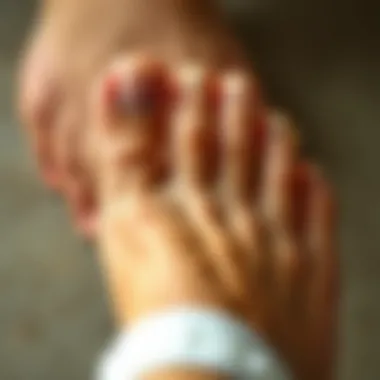
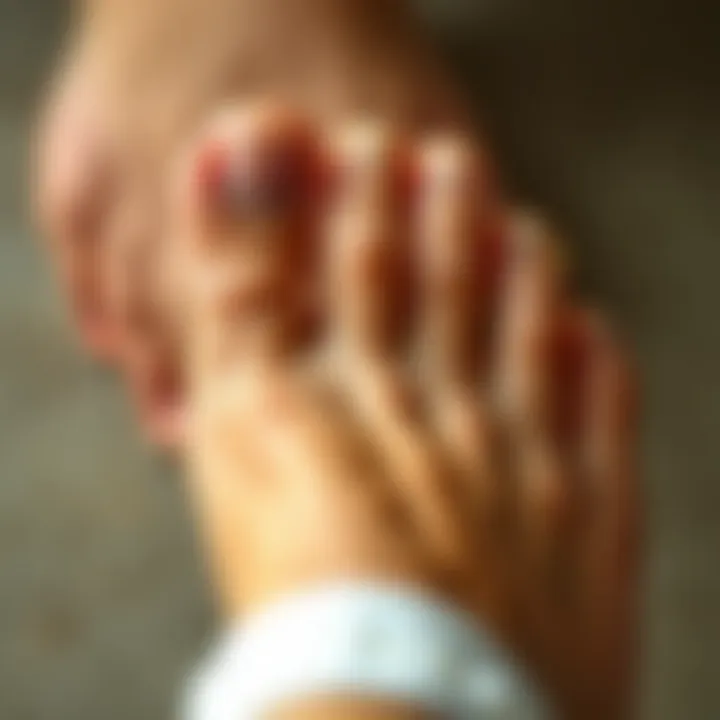
Benefits of choosing gel:
- Long-lasting: Can stay intact for weeks.
- Vibrant colors and shine: Offers richer hues.
Drawbacks:
- Potential Damage: Removal process can be harsh.
Avoiding Harsh Chemicals
The significance of steering clear of harsh chemicals cannot be overstated. Products loaded with toxic ingredients can wreak havoc on your nails and the surrounding skin. Making choices with a focus on safety is imperative. Sifting through labels might feel like hunting for a needle in a haystack, but it’s well worth the effort. Look for polishes that advertise as “3-free” or “5-free,” which omit a selection of harmful chemicals.
Only when armed with the knowledge of what to avoid can you truly appreciate the benefits: your nails remain healthier, and the risk of yellowing reduces significantly. Minimal exposure to harmful ingredients fosters an environment conducive to optimal nail health.
In summary, a mindful selection of products and practices lays a foundation for preserving the integrity and health of toenails. When one's toenail regimen reflects care and intelligence, the results are evident not just in appearance but also in resilience against discoloration.
Nutritional Considerations
Nutritional health plays a crucial role in maintaining not just our overall well-being but also the health of our toenails. What we eat reflects visibly on our nails, influencing their strength and color. By paying attention to specific vitamins and minerals, we can potentially stave off issues like yellow toenails. Healthy toenails require more than just external care; they thrive from the inside out. When we discuss nutritional considerations, we're not just making small talk about the latest dietary trends. It’s about nurturing our bodies with what they need to combat nail discoloration effectively and foster good nail growth.
In this section, we’ll dissect some key nutrients that help in keeping toenails healthy and vibrant and why incorporating them into your diet can be a game-changer.
Vitamin and Mineral Intake
Role of Biotin
Biotin, known as Vitamin H, is celebrated for its role in maintaining healthy hair, skin, and nails. Biotin is a water-soluble B vitamin that assists in the metabolism of fatty acids and amino acids, making it particularly beneficial for toenail health. One standout feature of biotin is its ability to strengthen keratin, the fundamental protein that composes nails. The beneficial aspect of biotin is quite significant; studies have shown that biotin supplementation can reduce nail brittleness, ultimately preventing the yellowing often caused by fungal infections.
However, it's worth noting that while biotin can improve nail strength, it’s best consumed through a balanced diet that includes eggs, nuts, and whole grains rather than as isolated supplements. Overconsumption can lead to side effects like skin rashes or digestive issues, so moderation is key.
Importance of Zinc
Zinc is another player that can't be overlooked. Known for its immune-boosting properties, this vital mineral also plays an undeniably important role in nail health. Zinc helps in cell division and protein synthesis, which are critical for healthy nail growth. A lack of zinc in one’s diet can lead to various nail problems, including discoloration and slow growth.
Zinc's best feature is its ability to combat infection, which directly ties into maintaining healthy nails. It works by strengthening nail structure and may even help in repairing damaged nails. Foods like oysters, red meat, and pumpkin seeds are excellent sources of zinc. However, excessive intake can lead to toxicity. Therefore, it is crucial to consume zinc within recommended daily allowances, ensuring it benefits without causing harm.
Hydration for Nail Health
When it comes to hydration, water is the unsung hero of nail health. Proper hydration is essential for overall body function and is often overlooked in discussions about nail care. Nails consist of cells that require water to stay pliable and resilient. Dry, brittle nails can lead to discoloration and a range of other problems. Drinking adequate amounts of water daily helps maintain moisture levels, preventing nails from becoming yellow and brittle.
Incorporating hydrating foods into your diet, like fruits and vegetables, can also help ensure your toenails receive the hydration they need from a nutritional standpoint. Proper hydration can aid in flushing out toxins, which may also impact the health of your toenails.
Addressing Existing Yellowing
Dealing with yellow toenails can be quite the nuisance, affecting not just the appearance of your feet, but also your confidence. Recognizing and addressing existing yellowing is crucial for restoring not only the visual aspect of your nails but also their overall health. Yellow toenails might be a sign of underlying issues that, if left unchecked, can lead to more severe complications. By focusing efforts on treatment options and seeking professional guidance, you can reclaim the health of your toenails and prevent further discoloration.
Topical Treatments
Topical treatments offer an effective strategy for combating yellow toenails. These are readily accessible solutions that can help restore the delicate balance while enhancing the visual appeal of your nails.
Antifungal Creams
Antifungal creams are a popular choice for treating yellow toenails, especially when the discoloration stems from fungal infections. These creams contain active ingredients designed to combat fungal growth directly at the source. They penetrate the nail bed and help eliminate the infection, which often helps lighten yellowness over time.
The key characteristic of these creams is their specific formulation targeting nail fungi. With options available over the counter, many people find this treatment convenient and easily accessible. However, results can vary widely. Some people find that they see immense improvement, while others may not get the results they want even after extended use. It's essential to follow instructions carefully and remain consistent in application for optimal results.
Advantages of antifungal creams include their non-invasive nature and ease of use. However, there are downsides too, like the potential for skin irritation or allergic reactions if you're sensitive to certain ingredients.
Discoloration Correctors
On the other hand, discoloration correctors work differently. They are primarily designed to specifically target yellowing by lifting the discoloration and providing more of a cosmetic fix. Often, these products contain bleaching agents or color-correcting compounds that can lighten the appearance of the nails.
Their selling point is often the speed of visible results, which can be quite alluring, especially if you're looking for an immediate cosmetic improvement. However, it's worth noting that while these correctors can improve the appearance, they might not address the root cause of the yellowing. Thus, they are often advised as a supplementary treatment rather than a standalone solution.
Some users appreciate the quick solutions that discoloration correctors provide, but they may not be suitable for all, especially those seeking deeper treatment for fungal infections.
Consulting Professionals
Sometimes, it's necessary to involve experts if home remedies and topical treatments don't yield satisfactory results. Consulting professionals can provide personalized advice and strategies tailored to your specific situation, making it a valuable step in maintaining nail health.
Podiatrists' Insights


Podiatrists are well-equipped with knowledge on a myriad of foot-related issues, including toenail yellowing. Consulting a podiatrist can help identify underlying conditions that may be contributing to yellowing, such as fungal infections or other nail disorders.
The unique feature of a podiatrist's insight is their clinical expertise—they offer not only treatments but also preventive care strategies based on your foot health and lifestyle. By evaluating your situation, podiatrists can recommend effective treatments and provide ongoing monitoring for optimal toenail health. A downside might be the cost associated with seeing a professional, however, the investment can be worth it for some individuals.
Nail Technicians' Recommendations
Lastly, nail technicians can also provide valuable recommendations, particularly in the realm of nail care and aesthetics. These professionals can guide you in choosing suitable products and techniques that can enhance nail appearance while minimizing further yellowing.
Nail technicians usually have firsthand experience with various products and can share insights on what works and what doesn't. While technicians focus more on cosmetic improvements rather than medical solutions, they can still help identify potential issues early on. However, one should note the distinction between their expertise and that of healthcare professionals; nail technicians may suggest products that don’t address deeper health issues.
"Taking proactive care of your toenails doesn't just enhance your appearance; it's an essential aspect of overall foot health."
In summary, addressing existing yellowing in toenails is a multifaceted approach requiring both home remedies and professional support. By considering topical treatments and consulting experts, you can finally leave that yellow behind and step confidently forward.
Maintaining Healthy Toenails Long-Term
Maintaining healthy toenails over the long haul is crucial, not just for aesthetics but also for overall foot health. Healthy nails serve as a shield against infections and other ailments. Keeping toenails in good condition contributes significantly to one’s self-esteem and overall well-being. It is essential to understand that just like any other aspect of personal hygiene, regular upkeep requires commitment and attention.
Regular Monitoring
Keeping Track of Changes
Keeping track of changes in your toenails is an essential aspect of maintaining nail health. Regular observation helps in identifying any abnormalities early on, which can be a sign of underlying issues. For instance, noticing changes in color or texture can prompt timely action, potentially preventing more significant concerns down the line. This vigilance fosters a proactive approach to health; instead of waiting for issues to worsen, you are equipped to address them in their infancy.
A key characteristic of keeping track of changes is its simplicity. It involves keen observation and noting any deviations from what’s normal for your nails. Many find this practice beneficial as it encourages mindfulness regarding body health. By developing this habit, you cultivate a keen eye for what’s usual for your nails, making it easier to spot when something's off.
One unique feature of this approach is that it's not exclusively about visual observation. Using a journal or a mobile app descibes changes can help with memory retention, leading to better decision-making regarding nail care. However, while the advantages are clear, one potential drawback could be overthinking minor changes, which might lead to unnecessary anxiety.
Recognizing Warning Signs
Recognizing warning signs related to toenail health is another valuable skill that ties into the overarching theme of maintaining healthy toenails. Being aware of symptoms like thickening, discoloration, or painful sensations can guide timely consulting with health professionals, thereby addressing issues before they escalate.
The fundamental characteristic of recognizing warning signs is that it formulates a basis for informed action. Instead of waiting until discomfort becomes unbearable, health-conscious individuals can take pragmatic steps to seek solutions. This proactive attitude sets the tone for a healthier lifestyle in general.
One unique aspect of recognizing warning signs is its empowering nature. Individuals feel more in control of their health decisions when they can confidently identify issues. The downside, however, lies in the possibility of misinterpreting minor issues as serious problems, which could lead to unnecessary visits to specialists or unwarranted fear.
Routine Care Practices
Schedule of Pedicures
Establishing a schedule for regular pedicures can substantially contribute to the long-term health of your toenails. Regularly tending to your toenails helps maintain a neat appearance, but it also provides an opportunity to inspect them for potential problems that you might not notice on a day-to-day basis. Professional nail technicians bring expertise to the table, ensuring both grooming and health needs are met.
One significant characteristic is the thoroughness that comes with professional care. Nail technicians often have the training to identify issues that may go unnoticed. It’s more than just cosmetics; professionals can guide preventative measures to maintain health, educating you along the way. Thus, it doubles as both a grooming and an educational experience.
However, scheduling pedicures requires a commitment to time and finances. The unique feature of professional pedicures is that while they offer many benefits, they also necessitate a regular expense and time investment from individuals. Those on a tighter budget might find this to be a hurdle.
At-Home Care Techniques
Not everyone has the luxury of frequently visiting salons for pedicures. Thankfully, at-home care techniques can also play a pivotal role in maintaining toenail health. Simple practices, such as regular nail trimming and using moisturizers, can go a long way. Establishing a habit of tending to your feet at home fosters both care and comfort.
One key characteristic of at-home techniques is accessibility. Anyone can acquire tools for foot care without breaking the bank. Moreover, incorporating these practices into a routine can give you a sense of ownership over your health. Furthermore, using natural ointments or oils for moisture can be a soothing ritual often enjoyed while watching television or reading.
The unique advantage is that it empowers individuals to take charge of their nail health without relying on external sources. On the flip side, at-home care requires discipline and can sometimes lead to gaps in knowledge if proper techniques are overlooked, resulting in less effective care than what a professional might offer.
In summary, maintaining healthy toenails long-term involves a combination of regular monitoring and routine care practices. Tailoring your approach to suit your lifestyle can lead to better outcomes.
By prioritizing these steps, you pave the way for healthier, more resilient toenails, enhancing not only their appearance but also your confidence in showcasing them.
Finale
In wrapping up our discussion on preventing yellow toenails, it’s clear that maintaining nail health holds significant importance not only for aesthetic reasons but also for overall well-being. Our toenails, much like the rest of us, tell a story about our lifestyle, health, and hygiene practices. Keeping toenails in good shape transcends mere beauty; it reflects a commitment to self-care and personal health, signaling a sense of pride and confidence.
Summary of Key Points
Throughout this article, several vital strategies have emerged, each playing a crucial role in the journey to healthier toenails. Here’s a quick recap:
- Understanding Discoloration: Knowing the causes and implications of yellow toenails helps inform your approach to prevention.
- Lifestyle Choices Matter: Choices in footwear and proper hygiene practices significantly affect nail health.
- Preventive Measures: Regular moisture maintenance and careful selection of nail products are essential.
- Nutrition's Role: Key vitamins, like biotin and minerals, including zinc, provide the necessary support for robust toenails.
- Addressing Existing Issues: If yellowing already exists, topical treatments and expert consultations can pave the way for recovery.
- Long-term Maintenance: Consistent monitoring and maintenance practices are vital for ongoing health.
Encouragement for Nail Health Awareness
The journey to healthy toenails doesn’t have to feel overwhelming. Every small step counts. From adopting beneficial lifestyle changes to recognizing when to seek professional advice, awareness and action are pivotal. If we pay attention, our toenails can be resilient and vibrant, free from the shadow of yellowing. Remember, it’s not just about aesthetics. Healthy toenails can be an indicator of overall health and vitality.
So, let’s take charge of our nail health with enthusiasm and diligence. Embrace these strategies, and don’t shy away from sharing them with friends and family. As we collectively raise awareness around toenail health, we foster a community that values self-care and embraces healthfulness in every aspect of life.
"Healthy toenails are not just a luxury, they’re a reflection of who you are and how you care for yourself."
By understanding the various elements of nail health and being proactive, we all can ensure our toenails remain not just a part of our feet, but a glowing testimony to our overall health.







